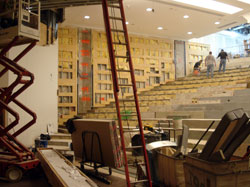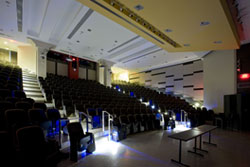
| Vol.
XXI No.
2 November / December 2008 |
| contents |
| Printable Version |
The Renovation of 10-250: A Case Study
Flash back to 1977. Jimmy Carter was president, “Night Fever” by the Bee Gees was the number one song, and gas was 55 cents per gallon. A six-month renovation of lecture hall 10-250 was complete and ready for the newest class of MIT freshmen. What did faculty and students encounter in the new space? To start, 450 purple-colored seats with honey oak wood trim and improved acoustics made 10-250 very popular. It was the meeting place at the Institute.
Flash forward to 2007. 10-250 was still the meeting place at the Institute, but after 30 years of oversubscribed 3.091 lectures, Nobel Prize announcements, and faculty meetings, the room looked worn and well used. Purple upholstery and oak trim, hip and smart in its day, now looked dated, the chairs were small, many chair backs were breaking and the carpeting was fraying. The lighting system with limited capabilities washed the room in harsh blue-white light. Tucked away in a machine room on the fourth floor, the air-conditioning system struggled to keep the room comfortable throughout the day; at times leaving students dreading their afternoon classes in a stuffy lecture hall. The meeting place at the Institute was failing to support the ambitions of the community.
The Prioritization Process
In 1988, the Institute set a goal (Project 2000) to update fully all 155 Registrar classrooms by the year 2000. To date, 58% of these rooms have been renovated. During the past 10 years we’ve made significant progress in the renovation of classrooms with a seating capacity of 25 – 50. The Registrar’s Office has been in process of developing a five-year renovation plan with help from Dean for Undergraduate Education Dan Hastings and the Faculty Classroom Committee. The group prioritized the need to focus our attention on large lecture halls such as 10-250. Only two of the Registrar’s 13 lecture halls that seat more than 100 students have been updated over the past 20 years. With strong support from the senior administration, the 10-250 project was funded during the annual CRSP cycle.
Why 10-250 first? 10-250 is the most requested lecture hall on campus. In an average week it is in use 90% of available time.
Thirty years of heavy use created a long list of room deficiencies. Taking the room off-line to replace only the seating and carpeting and not the lighting and air conditioning was not a sound strategy. A comprehensive approach to renovate 10-250 was required.
The Challenge:
Renovate 10-250 into an exceptional facility to meet the needs of today’s faculty, students, and the MIT community.
The renovation of a facility, especially a 450-seat lecture hall, possesses a unique set of challenges for any college campus. The summer break, the most common time for classroom renovations, would not provide sufficient enough time to complete a complex renovation of a space such as 10-250. Taking the room off-line for a semester coupled with the summer break was the only viable option, thus allowing an eight-month window of opportunity. Strategic planning and flexibility within the Registrar’s classroom inventory allows us to reassign classes and events to other spaces when a lecture hall is under renovation during a semester.
Other challenges included: maintaining a seating capacity of 450; designing a flexible lighting system to support various teaching styles, class recordings, and audiovisual modes; preserving the current high acoustical standards; and managing a noisy construction site within the main group during an eight-month renovation.
| Back to top |
The Design Process
A team was assembled spearheaded by the Registrar’s Office. A renovation of 10-250’s size requires a collaborative approach from many disciplines. Architects, mechanical, electrical and acoustical engineers, audiovisual consultant, and Department of Facilities project managers were all part of the team. Peter Bedrosian from the Registrar’s Office, with input from faculty who’ve lectured in the room over the years and from Professor John Brisson, chair of the Faculty Classroom Committee, led the effort to define and direct the project’s scope.
(click on image to enlarge)
Drawings were developed that reflected a modern, brightly lit aesthetic in keeping with MIT’s campus. Architect for the renovation, Tommy Quirk of DAIQ Architects, noted: “Working in concert with the MIT team we chose to set our course on a design that was contemporary to 2008, but respectful of the original classical detailing of the Main Group.” Raising the height of the ceiling redefined the space. The heavy, low hanging architectural boxes that lined the side stairs, reducing light levels, would be removed. The room would feel spacious and more open, but would preserve the qualities which made 10-250 an exceptional faculty-to-student learning environment. George Kocur, who teaches 1.00 in 10-250 this fall, concurs: “The room has more light, which is always a healthy thing, and the video projection and audio systems work very well. It’s a pleasure to teach in the new room, which is flexible enough to function well even for a large lab-based class such as ours.”
The Results
After the room was stripped of seats, walls, and ceiling, the renovation got underway. A new ceiling, to accommodate the various room utilities, was integrated with an angled “cloud” above the lecturer’s area. The cloud, while it may appear to be largely an aesthetic element, provides the necessary acoustical properties to project sound to the rear of the room while still allowing the redefinition of space and light, as well as hiding all the various electrical, audio, and mechanical support systems.
(click on image to enlarge)
New seating with integrated power at every seat is wider and more comfortable. Select rows, identified by blue LEDs, support hard-wired data ports at each seat. Seven access points of the latest in wireless technology provide excellent coverage throughout the lecture hall. Kocur notes: “Before renovation, we had to use power bars and power cords from a very limited number of outlets for a class of 150 or 200 students. Students also had to wait to upload their lab solutions at the end of class, because of limited wireless capacity. When that many students tried to upload simultaneously, not everyone got a connection.”
New climate controls located in the room allow the professor to control and adjust the temperature, if necessary, within minutes. Professor Donald Sadoway, who teaches 3.091 to a full house three days a week, notes the most significant improvement “is the climate control – the air supply and temperature now are reliable and conducive to learning. No more do I come to lecture finding the hall overheated. That’s a huge plus.”
Classrooms fulfill a major role in our community. In addition to being scheduled with academic classes, the rooms support lectures, movies, and a range of activities that make a difference in the lives of faculty and students. Our classrooms are used to bring people together, and serve as a true integration point of life and learning. Although significant progress has been made toward the completion of Project 2000, we have not yet reached the goal. The Registrar’s Office will continue to work with faculty and the senior administration in enhancing the teaching and learning environment. The 10-250 renovation demonstrates the impact an updated facility can have on the community.
| Back to top | |
| Send your comments |
| home this issue archives editorial board contact us faculty website |

